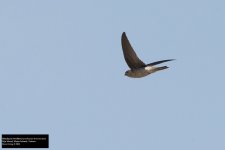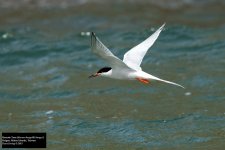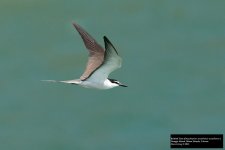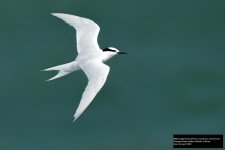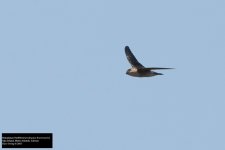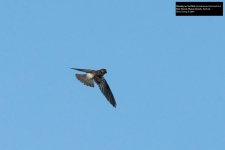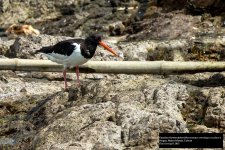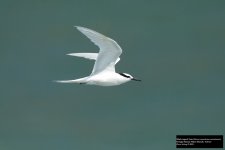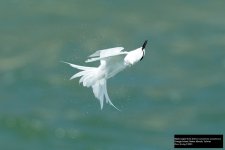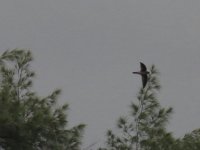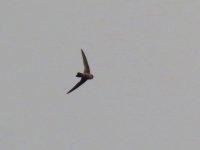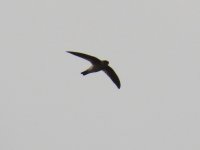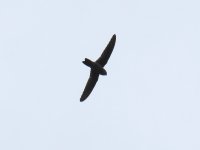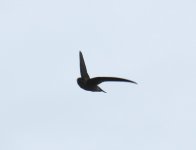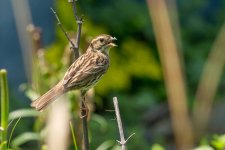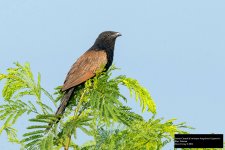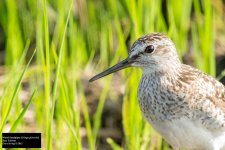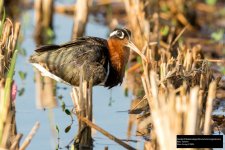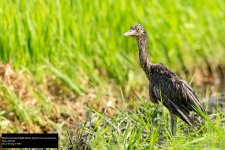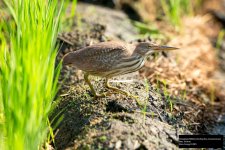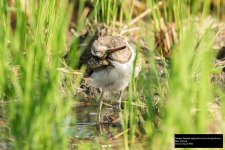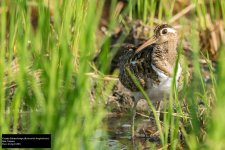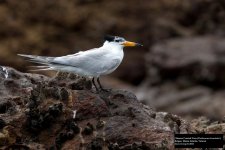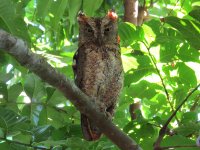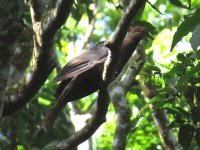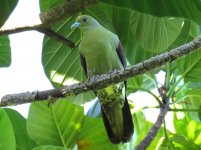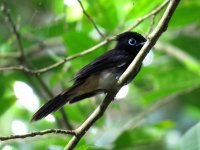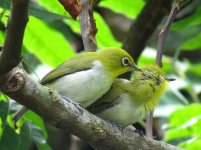-
Welcome to BirdForum, the internet's largest birding community with thousands of members from all over the world. The forums are dedicated to wild birds, birding, binoculars and equipment and all that goes with it.
Please register for an account to take part in the discussions in the forum, post your pictures in the gallery and more.
You are using an out of date browser. It may not display this or other websites correctly.
You should upgrade or use an alternative browser.
You should upgrade or use an alternative browser.
Taiwan - Birding Reports (1 Viewer)
- Thread starter Dave 2x
- Start date
More options
Who Replied?Here's the Swiftlet photo...please let me know if my ID is wrong.
Cheers
Dave
Hi Dave,
Can't help with the ID I'm afraid. I wasn't trying to make the point that your ID might be wrong, but that everybody's (including my own) assumptions stand a good chance of being wrong due to the simple fact that Aerodramus swiftlets are practically inseparable.
I have no literature at all on these things, but do know that ID involves minor differences in measurements, looking for feathering on legs, for dark spots in the feathers of the throat, or at the composition of the nest (what material it has selected etc), none of which is available on any of the birds we get here.
You can't help but be a bit worried by the summer arrival dates of all of these individuals (which alone would suggest that they are not Himalayan), and the fact that they prefer to hang around in low-lying coastal areas at times when Himalayan Swiftlet (as its name suggests) should be at high altitude!
Germain's Swiftlet apparently breeds as close to Taiwan as Hainan (and favours islands and coastal areas), and for my money is a much more likely culprit as it is a big candidate for range expansion given the effects of global warming (which is real and is happening apace). If they were actually breeding on Matzu, I would say you could call them Germain's without worry (Germain's now being my 'default' favourite).
I'm assuming that Uniform Swiftlet (by far the nearest breeding Aerodramus to Taiwan on northern Luzon) lacks a pale rump, but again have no literature on this species (which has to be another very likely candidate for vagrancy).
Last edited:
Some info that I found on Uniform (Island) Swiftlet Aerodramus vanikorensis here:
http://birdphotoph.proboards.com/thread/6730
And some thoughts: To my eye, these birds seem to have a fairly distinct breast band, with upper- and centre-breast obviously darker than clearly whiter throat. They also seem to get progressively darker towards the vent, with the darkest area below being towards the 'rear' of the underparts. On the form that occurs on Taiwan, the reverse is true, as birds get noticeably paler towards the vent.
In the sharpest of photos, the white chin and upper throat can be seen to be distinctly streaked. In my experience, this is unlike the swiftlet that occurs in Taiwan, which typically shows a chin which is slightly darker than the upper breast and not streaked.
I don't think that discussion of tail forks is at all useful given that this will vary due to wear and moult (both shed and growing feathers). Also, there are no photos of the upperside of these Philippine birds, so we're only seeing half of the bird. That said, I think Uniform Swiftlet can be ruled out for most Taiwan records on underpart colouration, but read with interest that they will disperse widely over northern Luzon in flocks of thousands following adverse weather!
http://birdphotoph.proboards.com/thread/6730
And some thoughts: To my eye, these birds seem to have a fairly distinct breast band, with upper- and centre-breast obviously darker than clearly whiter throat. They also seem to get progressively darker towards the vent, with the darkest area below being towards the 'rear' of the underparts. On the form that occurs on Taiwan, the reverse is true, as birds get noticeably paler towards the vent.
In the sharpest of photos, the white chin and upper throat can be seen to be distinctly streaked. In my experience, this is unlike the swiftlet that occurs in Taiwan, which typically shows a chin which is slightly darker than the upper breast and not streaked.
I don't think that discussion of tail forks is at all useful given that this will vary due to wear and moult (both shed and growing feathers). Also, there are no photos of the upperside of these Philippine birds, so we're only seeing half of the bird. That said, I think Uniform Swiftlet can be ruled out for most Taiwan records on underpart colouration, but read with interest that they will disperse widely over northern Luzon in flocks of thousands following adverse weather!
Last edited:
Dave 2x
Well-known member
Thanks Steve, very interesting.....I will leave it as Himalayan until another option is confirmed. However it certainly look identical to any Germain's I have seen in Thailand. Damn swifts are tough!
Here's a few more pics...
Cheers
Dave
Here's a few more pics...
Cheers
Dave
Attachments
Thanks Steve, very interesting.....I will leave it as Himalayan until another option is confirmed. However it certainly look identical to any Germain's I have seen in Thailand. Damn swifts are tough!
Just to create more confusion (or perhaps not), I managed to access the 'Swifts' monograph through Google Preview which yields the following information:
Himalayan Swiftlet: 'narrow, greyish rump-band with brown shaft streaks' (so should be visible in good photos); 'uppertail coverts as mantle' (presumably plain, not obviously pale-fringed); 'undertail coverts slightly darker grey, especially the longest, lacking whitish fringes although some show diffusely paler edges' (so overall plain-looking, without neat contrasts).
Edible-Nest (Germain's) Swiftlet: 'rump is marginally greyer than the mantle (referring to fuciphaga) ... in the palest examples (germani) the longest uppertail coverts can have slight pale fringing' (so may appear slightly mottled); 'undertail coverts ... clearly blackest (part of underparts) with pale grey fringing' (darker centres should contrast with fringe).
As regards habitat: Himalayan is 'mainly a highland species' (unlikely on the coast in summer, but obviously a possibility on passage); Germain's prefers 'small coastal islets and continental lowlands', breeding in sea caves. The following sentence can also be found under the description of Edible-Nest Swiftlet: 'Can occasionally be seen far out to sea (especially germani)'. You can take from that that it will wander!
Looking at photos of birds which have occurred on Taiwan, I'm now of the opinion that (i) Himalayan occurs here on passage based on birds with pale/plain vents, brown-streaked rumps, and vaguely 'hooded' looks formed by darker chins. These birds all have good tail forks (of negligible use, though, I think) and I have seen them feeding with House Swifts when they appear to be roughly similarly-sized (of greater use), and (ii) Germain's also occurs, and is probably breeding on islands offshore SE China, an opinion based on strong undertail and uppertail covert pattens (valid?) on birds in photos such as yours (Dave's), time of year they are recorded (and number of individuals), and habitat preference. I could, of course, be wrong on all counts!
Last edited:
Paul Rhodes
Well-known member
Thanks Steve, very interesting.....I will leave it as Himalayan until another option is confirmed. However it certainly look identical to any Germain's I have seen in Thailand. Damn swifts are tough!
Here's a few more pics...
Cheers
Dave
Your trip sounds fantastic Dave enjoyed your pics black naped tern is a really smart bird and pleased you finally nailed the Chinese crested. The swiftlet ID is sadly beyond my abilities in fact whilst I noted Himalayan occurred on passage in spring when I was in Taiwan the presence of potential breeding swiftlets in the offshore islands is intriguing and if proved could add to their conservation value in the long term. All the very best.
Dave 2x
Well-known member
Just to create more confusion (or perhaps not), I managed to access the 'Swifts' monograph through Google Preview which yields the following information:
Himalayan Swiftlet: 'narrow, greyish rump-band with brown shaft streaks' (so should be visible in good photos); 'uppertail coverts as mantle' (presumably plain, not obviously pale-fringed); 'undertail coverts slightly darker grey, especially the longest, lacking whitish fringes although some show diffusely paler edges' (so overall plain-looking, without neat contrasts).
Edible-Nest (Germain's) Swiftlet: 'rump is marginally greyer than the mantle (referring to fuciphaga) ... in the palest examples (germani) the longest uppertail coverts can have slight pale fringing' (so may appear slightly mottled); 'undertail coverts ... clearly blackest (part of underparts) with pale grey fringing' (darker centres should contrast with fringe).
As regards habitat: Himalayan is 'mainly a highland species' (unlikely on the coast in summer, but obviously a possibility on passage); Germain's prefers 'small coastal islets and continental lowlands', breeding in sea caves. The following sentence can also be found under the description of Edible-Nest Swiftlet: 'Can occasionally be seen far out to sea (especially germani)'. You can take from that that it will wander!
Looking at photos of birds which have occurred on Taiwan, I'm now of the opinion that (i) Himalayan occurs here on passage based on birds with pale/plain vents, brown-streaked rumps, and vaguely 'hooded' looks formed by darker chins. These birds all have good tail forks (of negligible use, though, I think) and I have seen them feeding with House Swifts when they appear to be roughly similarly-sized (of greater use), and (ii) Germain's also occurs, and is probably breeding on islands offshore SE China, an opinion based on strong undertail and uppertail covert pattens (valid?) on birds in photos such as yours (Dave's), time of year they are recorded (and number of individuals), and habitat preference. I could, of course, be wrong on all counts!
I guess we may never know for sure...but your theory sounds convincing to me. Here's another couple of photos including one of the rump.
Cheers
Dave
Attachments
Last edited:
Paul Rhodes
Well-known member
I guess we may never know for sure...but your theory sounds convincing to me. Here's another couple of photos including one of the rump.
Cheers
Dave
It may be worth posting it on the ID forum for discussion.
Dave 2x
Well-known member
It may be worth posting it on the ID forum for discussion.
Good idea...done.
http://www.birdforum.net/showthread.php?p=3242298#post3242298
Cheers
Dave
Last edited:
At least one (and possibly two) swiftlets in Anping (Tainan) this afternoon. Tiny little things (way too quick for my cheapo camera), and for me they really have to be Germain's.
There are now 12 Germain's Swiftlets in Anping (just north of the harbour). Got similarly poor photos again this morning. Will have another go this afternoon if the rain stops!
(The best I could do have been added!)
Attachments
Last edited:
Steve - I am sure this one is easy for you, but it's confusing me! This was a Bunting that we saw at Guishan (Turtle) Island in Ilan on 2 May 2015.
Appreciate any help on the ID!
Cheers
Dave
Hi Dave,
It's just a female Black-faced Bunting for me. Rustic Bunting should have at least some reddish-brownish on nape, rump and flanks (streaks), regardless of age/sex.
Steve
Dave 2x
Well-known member
Hi Dave,
It's just a female Black-faced Bunting for me. Rustic Bunting should have at least some reddish-brownish on nape, rump and flanks (streaks), regardless of age/sex.
Steve
Thanks Steve...for some reason I thought it was different, but you have cleared up my doubts!
A Watercock is being reported from Ilan which is tempting me to try next weekend if the reports continue.
Cheers
Dave
Steve - just finished reading your blog on your Borneo trip....very jealous of that Whitehead's Spiderhunter and many others. Sounds like you had a great trip to one of my favourite places, Congrats!
Cheers
Dave
Thanks, Dave. I enjoyed this trip a lot and was more than happy with the birds we encountered, the diversity of which I would say was high. I'm sure this gets even higher if you head off to eastern Sabah, too, but I prefer giving places a bit more time these days rather than charging about all over the place (twitching is a domestic pursuit!).
Steve
Dave 2x
Well-known member
Sunday 26 July 2015
Summer in Taiwan is not much fun....the heat makings birding extremely difficult and the number of birds at this time of year means I usually don't leave the aircon so often.
Reports of a Watercock at Ilan got my attention, so we made a trip yesterday even though the bird had not been seen for a week. As expected we dipped and had to settle for some of the more common species found in these paddy fields. Highlights for me were an obliging Lesser Coucal and numbers of Greater Painted-snipes which were quite vocal.
http://ebird.org/ebird/view/checklist?subID=S24383247
Here's a few pics...
Cheers
Dave
Summer in Taiwan is not much fun....the heat makings birding extremely difficult and the number of birds at this time of year means I usually don't leave the aircon so often.
Reports of a Watercock at Ilan got my attention, so we made a trip yesterday even though the bird had not been seen for a week. As expected we dipped and had to settle for some of the more common species found in these paddy fields. Highlights for me were an obliging Lesser Coucal and numbers of Greater Painted-snipes which were quite vocal.
http://ebird.org/ebird/view/checklist?subID=S24383247
Here's a few pics...
Cheers
Dave
Attachments
Dave 2x
Well-known member
A few more pics from the weekend including perhaps the ugliest Night-Heron I have ever seen.
Have also added another Chinese-Crested Tern pic from last month.
Cheers
Dave
Have also added another Chinese-Crested Tern pic from last month.
Cheers
Dave
Attachments
Jeff Hopkins
Just another...observer

A few more pics from the weekend including perhaps the ugliest Night-Heron I have ever seen.
Wow. Did something try to drown it? :eek!:
The usual Lanyu stuff (obviously on Lanyu): 31/7-1/8. Lanyu (Ryukyu) Scops Owl, Philippine Cuckoo-dove, Whistling Green Pigeon, periopthalmica Japanese Paradise Flycatcher, Lowland White-eye.
Attachments
Last edited:
Users who are viewing this thread
Total: 2 (members: 0, guests: 2)




